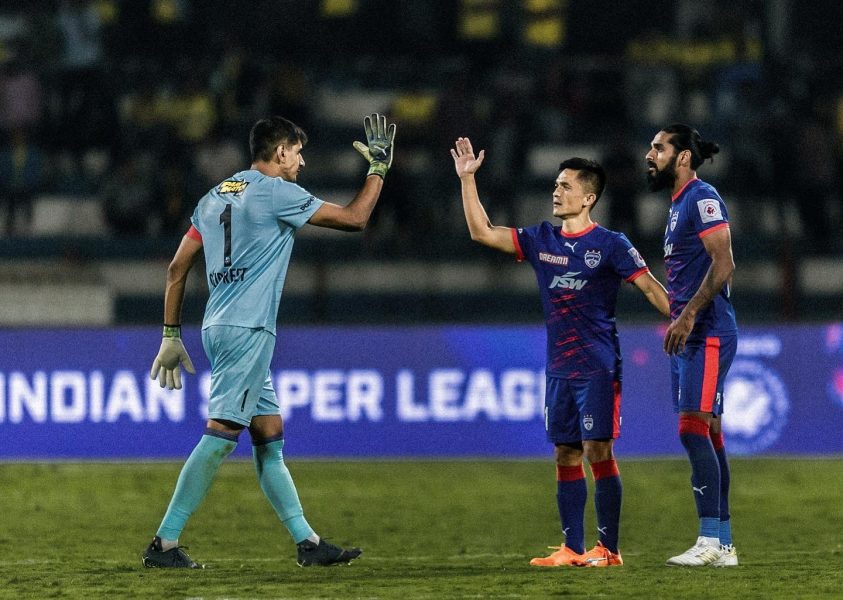
Sunil Chhetri's controversial ISL goal: What does free kicks law say?

On Friday (March 3), a major controversy arose in the Indian Super League (ISL) football tournament when Kerala Blasters FC forfeited its play-off match against Bengaluru FC due to Sunil Chhetri’s goal at the Sree Kanteerava Stadium in Bengaluru.
Although Chhetri’s match-winning free-kick goal secured Bengaluru FC’s place in the semi-finals of the ISL, fans are still directing their frustration towards him.
Why Chhetri’s goal was awarded
According to Sunil Chhetri, he was granted permission by the referee to take the free-kick that led to the disputed goal, as he saw an opportunity to score and didn’t want the wall or the whistle.
He believed that Luna, a player from the opposing team, was blocking his chance to score, but on that particular day, the ball went in.
.@chetrisunil11's goal helps @bengalurufc reach the #HeroISL 2022-23 semi-finals where they will face league winners #MumbaiCityFC!
Watch the full highlights! 📺#BFCKBFC #HeroISLPlayoffs #LetsFootball #BengaluruFC #KeralaBlasters
— Indian Super League (@IndSuperLeague) March 4, 2023
Chhetri made these comments after the match, where his goal secured Bengaluru FC’s place in the semi-finals of the ISL.
What does free kicks law say?
According to International Football Association Board’s (IFAB) Law 13, section 3 of Offences and Sanctions, “If, when a free kick is taken, an opponent is closer to the ball than the required distance, the kick is retaken unless the advantage can be applied; but if a player takes a free kick quickly and an opponent who is less than 9.15 m (10 yds) from the ball intercepts it, the referee allows play to continue. However, an opponent who deliberately prevents a free kick being taken quickly must be cautioned for delaying the restart of play.”
“If, when a free kick is taken, an attacking team player is less than 1 m (1 yd) from a ‘wall’ formed by three or more defending team players, an indirect free kick is awarded.
“If, when a free kick is taken by the defending team inside its penalty area, any opponents are inside the penalty area because they did not have time to leave, the referee allows play to continue. If an opponent who is in the penalty area when the free kick is taken, or enters the penalty area before the ball is in play, touches or challenges for the ball before it is in play, the free kick is retaken.
“If, after the ball is in play, the kicker touches the ball again before it has touched another player, an indirect free kick is awarded; if the kicker commits a handball offence:
“a direct free kick is awarded
“a penalty kick is awarded if the offence occurred inside the kicker’s penalty area unless the kicker was the goalkeeper in which case an indirect free kick is awarded.”
Previous instances
Nacho’s goal against Sevilla during the La Liga 2016-17 season was an excellent example of a quick, clever free-kick, particularly when a similar debate had occurred among football enthusiasts. Oliver, who formerly served as a referee and is now an analyst, affirmed that the goal was correctly awarded when he spoke on Radio MARCA.
He clarified that Nacho’s action was permissible because the ball wasn’t in motion when he took the shot, and therefore Undiano, the referee, was justified in allowing the goal.
Also read: Was Chhetri’s ‘quick free kick’ goal against Kerala Blasters fair? Debate hots up
In 2004, Thierry Henry also scored a goal against Chelsea from a quick-free kick, and the referee in that game, Graham Poll (now retired), provided a valid explanation for his decision to award the goal.
A referee’s perspective
In regards to the rule for goals scored from free-kicks, Graham Poll explained his perspective in an interview with Bleacher Report. He first established that if the attacking team is fouled, they hold the advantage. When a free-kick is awarded near the penalty area, players are given the opportunity to choose whether they want it taken quickly or slowly.
If they opt for a quick free-kick, they forfeit the right to retake it, even if the ball strikes a defender who is three yards away or goes over the bar.
Also read: Kerala Blasters forfeit ISL game | Sunil Chhetri: ‘Never seen in 22-year career’
Conversely, if they opt for a slow free-kick, they must wait for the referee’s whistle after the wall has been placed.
Poll emphasised that there is no requirement in the laws of the game for the referee to signal when the free-kick can be taken, but as long as the ball is stationary and in the correct position, the attacking team can take it as quickly as they wish.


